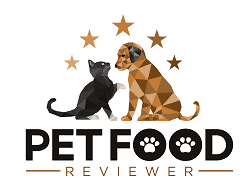What Is Xanthan Gum?
Xanthan Gum is a unique ingredient that is produced from naturally occurring bacteria known as Xanthomonas Camperstris, which are fermented using a carbohydrate source.
This fermenting process is quite similar to the production of alcohol in drinks like Beer or Cider, where Yeast is used instead.
However, Xanthomonas Camperstris produces a substance with a gummy-like texture. This substance is then pasteurized to kill the bacteria and then filtered and dried to produce a white powder-like substance.
While we’ve described this process as if it is happening in a petri dish, it, in fact, happens at an industrial scale that produces kilograms rather than grams of Xanthan Gum.
One of the key advantages of Xanthan Gum is that this white powder is relatively neutral in taste and smell, which allows it to be added to other foods without it being noticed.
Why Is Xanthan Gum Used In Pet Food?
Xanthan Gum is most commonly found in wet or canned pet food recipes in tiny quantities. Its primary purpose in these wet pet food recipes is to act as a binding agent or a thickener.
It is important that wet pet food recipes contain thickening or binding agents such as this to ensure that the food has a consistent texture and thickness and the ingredients do not separate from each other.
If ingredients such as these are not added, wet pet food can often be unappealing or unpleasant to eat for many pets.
There are several other common binding or thickening agents used in wet pet food, including Carrageenan and Guar Gum, as well as starch ingredients like Potato Starch and Tapioca Starch.
The reason that Xanthan Gum may be chosen by a pet food brand over an alternative is that it is an ingredient that can be easily sourced at scale as it is relatively cost-effective.
The cost of ingredients is an incredibly important component of pet food as brands fight to keep their costs down.
Is Xanthan Gum Bad For Pets?
There is conflicting evidence and opinion about the use of Xanthan Gum in pet food recipes, but the general consensus is that it is unlikely to cause any noticeable effects on most dogs or cats.
This is as the quantity used in pet food recipes is incredibly small and likely less than 1% of the overall content of a formula. There are many other ingredients in much higher proportions that could cause health problems or adverse effects.
However, we will say that some pets may experience some mild side effects from the presence of Xanthan Gum, such as loose stools or an upset stomach; however, it is hard to say whether these symptoms are definitively caused by the Xanthan Gum.
Some in the industry do not like Xanthan Gum because they claim that it is not a natural product as it is artificially created by mixing bacteria and dense carbohydrates.
While this may be true, and in an ideal world, all ingredients found in pet food are natural, we believe there are several other issues that should likely be addressed before this.
Another talking point is the carbohydrates that are often mixed with the Xanthomonas bacteria are from grain ingredients like Corn or Wheat, which are equally controversial additions to pet food.
While most of this is consumed or filtered out, there may be some remnants that would then be present in the pet food recipe.
Lastly, although rare, some confuse Xanthan Gum with another similarly named ingredient called Xylitol.
Xylitol is extremely toxic to dogs and can even be lethal, which is why it has no place in pet food. Thankfully Xanthan Gum and Xylitol are completely unrelated to each other.
Pet Food Brands That Use Xanthan Gum
Xanthan Gum is a common ingredient in wet/canned pet food recipes, and due to that, there are many recognizable brands that utilize it.
Some well-known examples include Royal Canin, Pedigree, Purina Pro Plan, Blue Buffalo, Merrick, Nutro, and Iams.
While performing research on the use of ingredients in dog food recipes, we found that of the 100 most popular wet dog food recipes on Chewy.com, 13 of them contained Xanthan Gum, which is not insignificant.
However, this is still far less than other thickening agents, such as Guar Gum, which were found in 73 of the 100 most popular recipes.
You can see an example of the use of Xanthan Gum below in the ingredient list of Iam’s ProActive Health Adult Wet Dog Food, where Xanthan Gum features alongside Carrageenan as a minor ingredient.
While some other binding agents such as Carrageenan, have seen a significant decrease in use over the last few years, Xanthan Gum appears to be relatively unchanged, with many of the big brands continuing to use it in minor quantities.
If you are concerned about Xanthan Gum and do not wish for your dog to consume it, we recommend closely inspecting your prospective dog food recipe’s ingredient list or choosing to go with a dry dog food recipe as these would not contain such ingredients.
If you need help with this, be sure to check out our Dog Food Guide or our Pet Food Brand Review Index.




